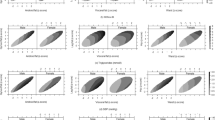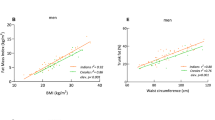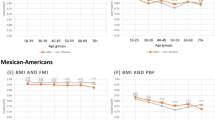Abstract
Objective:
To investigate whether leptin and adiponectin are associated with body fat composition in a South Asian population independent of metabolic variables.
Design:
Cross-sectional study.
Subjects:
150 South Asian men and women, between the ages of 45–79 years, in the San Francisco Bay Area without pre-existing clinical cardiovascular disease.
Measurements:
Blood samples were obtained to measure glucose metabolism variables, lipid profiles and adipokines. Total body fat was determined using dual-energy X-ray absorptiometry. Abdominal computed tomography was used to measure subcutaneous, visceral and hepatic fat.
Results:
Average body mass index (BMI) was overweight at 26.1±4.6 kg m−2 and did not differ by sex. However, women had significantly more total body fat (P<0.001) and subcutaneous fat (P<0.001) than men, whereas men had significantly more visceral fat (P<0.001) and hepatic fat (P=0.04) than women. Women had significantly higher levels of adiponectin (P<0.01) and leptin (P<0.01). In sex-stratified analyses, leptin was strongly associated with all-body composition measures in women (P<0.05) as well as in men (P<0.05 except for hepatic fat), whereas there was an insignificant trend towards an inverse association between adiponectin and body composition in both women and men, which was significant in combined bivariate analyses. In multivariate analyses, leptin was strongly associated with all measures of adiposity, including BMI (P<0.001), total body fat (P<0.001), visceral fat (P<0.001) and hepatic fat (P=0.01). However, adiponectin's inverse association with adiposity was significantly attenuated by high-density lipoprotein (HDL), triglycerides and insulin resistance. The association between adipokines and diabetes was markedly attenuated after adjusting for body composition.
Conclusion:
Despite only modestly elevated BMI, South Asians have elevated levels of total and regional adiposity. Leptin is strongly associated with adiposity, whereas adiponectin's association with adiposity is attenuated by metabolic variables in South Asians. Adipokines in association with adiposity have an important role in the development of diabetes.
This is a preview of subscription content, access via your institution
Access options
Subscribe to this journal
Receive 12 print issues and online access
$259.00 per year
only $21.58 per issue
Buy this article
- Purchase on Springer Link
- Instant access to full article PDF
Prices may be subject to local taxes which are calculated during checkout

Similar content being viewed by others
References
Deurenberg-Yap M, Schmidt G, van Staveren WA, Deurenberg P . The paradox of low body mass index and high body fat percentage among Chinese, Malays and Indians in Singapore. Int J Obes Relat Metab Disord 2000; 24: 1011–1017.
Lear SA, Humphries KH, Kohli S, Chockalingam A, Frohlich JJ, Birmingham CL . Visceral adipose tissue accumulation differs according to ethnic background: results of the Multicultural Community Health Assessment Trial (M-CHAT). Am J Clin Nutr 2007; 86: 353–359.
Misra A, Khurana L . Obesity-related non-communicable diseases: South Asians vs. White Caucasians. Int J Obes 2011; 35: 167–187.
Ghosh A . Interrelationship of waist circumference and subcutaneous fat with metabolic and blood pressure measures among Asian Indian men. Anthropol Anz 2007; 65: 75–85.
Misra A, Singhal N, Khurana L . Obesity, the metabolic syndrome, and type 2 diabetes in developing countries: role of dietary fats and oils. J Am Coll Nutr 2010; 29 (Suppl 3): 289S–301S.
Tilg H, Moschen AR . Adipocytokines: mediators linking adipose tissue, inflammation and immunity. Nat Rev Immunol 2006; 6: 772–783.
Berg AH, Scherer PE . Adipose tissue, inflammation, and cardiovascular disease. Circ Res 2005; 96: 939–949.
Lago F, Dieguez C, Gomez-Reino J, Gualillo O . The emerging role of adipokines as mediators of inflammation and immune responses. Cytokine Growth Factor Rev 2007; 18: 313–325.
Rabe K, Lehrke M, Parhofer KG, Broedl UC . Adipokines and insulin resistance. Mol Med 2008; 14: 741–751.
Considine RV, Sinha MK, Heiman ML, Kriauciunas A, Stephens TW, Nyce MR et al. Serum immunoreactive-leptin concentrations in normal-weight and obese humans. N Engl J Med 1996; 334: 292–295.
Schulze MB, Rimm EB, Shai I, Rifai N, Hu FB . Relationship between adiponectin and glycemic control, blood lipids, and inflammatory markers in men with type 2 diabetes. Diabetes Care 2004; 27: 1680–1687.
Hamdy O, Porramatikul S, Al-Ozairi E . Metabolic obesity: the paradox between visceral and subcutaneous fat. Curr Diabetes Rev 2006; 2: 367–373.
Mohan V, Deepa R, Pradeepa R, Vimaleswaran KS, Mohan A, Velmurugan K et al. Association of low adiponectin levels with the metabolic syndrome – the Chennai Urban Rural Epidemiology Study (CURES-4). Metabolism 2005; 54: 476–481.
Wasim H, Al-Daghri NM, Chetty R, McTernan PG, Barnett AH, Kumar S . Relationship of serum adiponectin and resistin to glucose intolerance and fat topography in South-Asians. Cardiovasc Diabetol 2006; 5: 10–14.
Kanaya AM, Wassel CL, Mathur D, Stewart A, Herrington D, Budoff MJ et al. Prevalence and correlates of diabetes in South Asian Indians in the United States: findings from the metabolic syndrome and atherosclerosis in South Asians living in America and multi-ethnic study of atherosclerosis studies. Metab Syndr Relat Disord 2010; 8: 157–164.
Bild DE, Bluemke DA, Burke GL, Detrano R, Diez Roux AV, Folsom AR et al. Multi-ethnic study of atherosclerosis: objectives and design. Am J Epidemiol 2002; 156: 871–881.
Matthews DR, Hosker JP, Rudenski AS, Naylor BA, Treacher DF, Turner RC . Homeostasis model assessment: insulin resistance and beta-cell function from fasting plasma glucose and insulin concentrations in man. Diabetologia 1985; 28: 412–419.
American Diabetes Association. Screening for type 2 diabetes. Diabetes Care 2003; 26 (Suppl 1): S21–S24.
Grundy SM, Cleeman JI, Daniels SR, Donato KA, Eckel RH, Franklin BA et al. Diagnosis and management of the metabolic syndrome: an American Heart Association/National Heart, Lung, and Blood Institute Scientific Statement. Circulation 2005; 112: 2735–2752.
Cameron AJ, Zimmet PZ, Soderberg S, Alberti KGMM, Sicree R, Tuomilehto J et al. The metabolic syndrome as a predictor of incident diabetes mellitus in Mauritius. Diabet Med 2007; 24: 1460–1469.
Ramachandran A, Snehalatha C, Satyavani K, Sivasankari S, Vijay V . Metabolic syndrome in urban Asian Indian adults – a population study using modified ATP III criteria. Diabetes Res Clin Pract 2003; 60: 199–204.
Jacobs JE, Birnbaum BA, Shapiro MA, Langlotz CP, Slosman F, Rubesin SE et al. Diagnostic criteria for fatty infiltration of the liver on contrast-enhanced helical CT. Am J Roentgenol 1998; 171: 659–664.
Ricci C, Longo R, Gioulis E, Bosco M, Pollesello P, Masutti F et al. Noninvasive in vivo quantitative assessment of fat content in human liver. J Hepatol 1997; 27: 108–113.
Piekarski J, Goldberg HI, Royal SA, Axel L, Moss AA . Difference between liver and spleen CT numbers in the normal adult: its usefulness in predicting the presence of diffuse liver disease. Radiology 1980; 137: 727–729.
Ramachandran A, Snehalatha C, Vijay V, Satyavani K, Latha E, Haffner SM . Plasma leptin in non-diabetic Asian Indians: association with abdominal adiposity. Diabet Med 1997; 14: 937–941.
Chandalia M, Lin P, Seenivasan T, Livingston EH, Snell PG, Grundy SM et al. Insulin resistance and body fat distribution in South Asian men compared to Caucasian men. PLoS ONE 2007; 2: e812.
Lilja M, Rolandsson O, Shaw JE, Pauvaday V, Cameron AJ, Tuomilehto J et al. Higher leptin levels in Asian Indians than Creoles and Europids: a potential explanation for increased metabolic risk. Int J Obes 2010; 34: 878–885.
Mente A, Razak F, Blankenberg S, Vuksan V, Davis AD, Miller R et al. Ethnic variation in adiponectin and leptin levels and their association with adiposity and insulin resistance. Diabetes Care 2010; 33: 1629–1634.
Soderberg S, Zimmet P, Tuomilehto J, Chitson P, Gareeboo H, Alberti KGMM et al. Leptin predicts the development of diabetes in Mauritian men, but not women: a population-based study. Int J Obes 2007; 31: 1126–1133.
Banerji MA, Faridi N, Atluri R, Chaiken RL, Lebovitz HE . Body composition, visceral fat, leptin, and insulin resistance in Asian Indian men. J Clin Endocrinol Metab 1999; 84: 137–144.
Acknowledgements
The MASALA study was funded by K23 HL080026-01, the University of California, San Francisco Research Evaluation and Allocation Committee and by NIH/NCRR UCSF-CTSI Grant Number UL1 RR024131-01.
Author information
Authors and Affiliations
Corresponding author
Ethics declarations
Competing interests
The authors declare no conflict of interest.
Rights and permissions
About this article
Cite this article
Shah, A., Hernandez, A., Mathur, D. et al. Adipokines and body fat composition in South Asians: results of the Metabolic Syndrome and Atherosclerosis in South Asians Living in America (MASALA) study. Int J Obes 36, 810–816 (2012). https://doi.org/10.1038/ijo.2011.167
Received:
Revised:
Accepted:
Published:
Issue Date:
DOI: https://doi.org/10.1038/ijo.2011.167
Keywords
This article is cited by
-
Total adiponectin in overweight and obese subjects and its response to visceral fat loss
BMC Endocrine Disorders (2019)
-
South Asian Cardiovascular Disease & Cancer Risk: Genetics & Pathophysiology
Journal of Community Health (2018)
-
Less favorable body composition and adipokines in South Asians compared with other US ethnic groups: results from the MASALA and MESA studies
International Journal of Obesity (2016)
-
The relationship between regional abdominal fat distribution and both insulin resistance and subclinical chronic inflammation in non-diabetic adults
Diabetology & Metabolic Syndrome (2014)
-
Total and high molecular weight adiponectin and ethnic-specific differences in adiposity and insulin resistance: a cross-sectional study
Cardiovascular Diabetology (2013)



